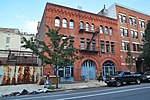Vanderbilt Avenue station (BMT Myrtle Avenue Line)
1888 establishments in New York (state)1969 disestablishments in New York (state)Brooklyn railway station stubsDefunct BMT Myrtle Avenue Line stationsDefunct New York City Subway stations located aboveground ... and 3 more
Former elevated and subway stations in BrooklynRailway stations closed in 1969Railway stations in the United States opened in 1888
Vanderbilt Avenue was a station on the now-demolished BMT Myrtle Avenue Line and BMT Lexington Avenue Line in Brooklyn, New York City. It had two tracks and one island platform. It closed on October 4, 1969, along with the rest of the elevated structure, after a fire. The next stop to the north was Washington Avenue, and to the south was Navy Street.
Excerpt from the Wikipedia article Vanderbilt Avenue station (BMT Myrtle Avenue Line) (License: CC BY-SA 3.0, Authors).Vanderbilt Avenue station (BMT Myrtle Avenue Line)
Myrtle Avenue, New York Brooklyn
Geographical coordinates (GPS) Address Phone number Nearby Places Show on map
Geographical coordinates (GPS)
| Latitude | Longitude |
|---|---|
| N 40.693138 ° | E -73.969847 ° |
Address
Subway
Myrtle Avenue 400
11205 New York, Brooklyn
New York, United States
Open on Google Maps





